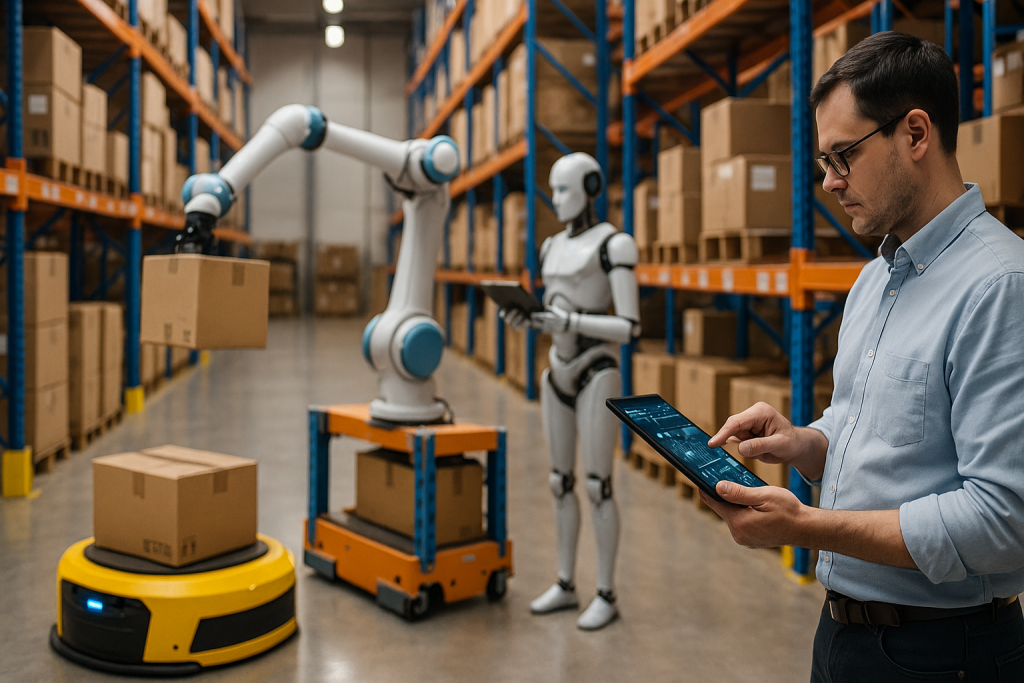By Martin Vassilev / 30 Oct, 2025
Modern inventory management has evolved far beyond basic spreadsheets and manual stock counts. In today’s fast-paced global supply chain, automation and artificial intelligence (AI) have become indispensable. These technologies not only optimize warehouse operations but also redefine how businesses predict demand, control inventory accuracy, and enhance customer satisfaction.
In a world where real-time visibility, data-driven decision-making, and operational efficiency determine profitability, companies leveraging AI and automation lead the race. This article explores how automation and AI are transforming inventory management systems and why adopting them is essential for sustainable business growth.
Traditional inventory systems relied heavily on human intervention—manual data entry, periodic audits, and reactive ordering. However, these approaches were prone to error and inefficiency.
With the integration of AI-driven automation, businesses now operate on proactive, predictive, and fully optimized frameworks that analyze millions of data points in seconds.
According to ByExpress, AI-enabled logistics platforms now predict demand spikes, identify supply bottlenecks, and automatically trigger replenishment orders before shortages occur—turning warehouses into self-optimizing ecosystems.
Automated systems integrate IoT sensors, RFID tags, and barcode scanners to track every item’s movement from warehouse to delivery. This enables real-time inventory visibility, minimizing lost stock and ensuring that businesses know exactly what’s available, where it is, and when it will move.
For example, real-time inventory tracking technologies like those used in ByExpress’s logistics operations allow managers to access dynamic dashboards that reflect live stock levels across multiple locations—critical for omnichannel fulfillment.
Automation minimizes manual data entry, a major source of inaccuracies. Warehouse robots and AI-driven scanners ensure consistent accuracy in receiving, picking, and shipping operations.
This directly impacts profitability since even small counting errors can lead to costly stockouts or overstocking.
AI-powered warehouse automation ensures every inch of storage space is used efficiently. Automated shelving systems and guided robotics determine optimal item placement based on weight, frequency, and demand.
This approach aligns with ByExpress’s warehouse efficiency strategies to help companies achieve higher throughput and reduced labor costs.
AI models analyze historical sales data, seasonal trends, and even weather forecasts to anticipate future demand. Unlike traditional forecasting, AI-driven systems adjust in real-time, learning from ongoing sales fluctuations.
This proactive approach helps reduce stockouts, excess inventory, and capital tied up in unused goods.
Incorporating these insights is crucial for companies managing multi-location logistics or seasonal inventory cycles. For a deeper dive into such optimization, see Optimizing Your Supply Chain for Global Challenges.
AI automates the replenishment process. Once an item’s stock level dips below a specific threshold, the system automatically generates a purchase order—choosing the most cost-effective supplier based on price, lead time, and reliability.
This system not only maintains inventory balance but also prevents over-ordering, reducing waste and improving cash flow.
Machine learning algorithms also drive dynamic pricing models, adjusting product prices based on real-time market demand, competitor pricing, and available inventory.
In e-commerce and retail, this AI-driven pricing helps maximize margins while maintaining competitive positioning.

AMRs are now essential in large-scale distribution centers. These robots navigate warehouse layouts using LIDAR sensors and AI mapping, picking and delivering goods faster than manual labor.
The result: shorter order cycle times and reduced labor dependency.
Equipped with machine vision and AI-driven motion control, robotic arms can identify, grasp, and sort thousands of SKUs with minimal error.
This automation drastically enhances speed, consistency, and accuracy in fulfillment operations, echoing findings from The Future of Warehouse Automation.
Drones equipped with computer vision can scan shelves, track inventory, and identify misplaced items without interrupting daily operations.
This saves hours of manual auditing and boosts inventory accuracy beyond 99%.
Modern inventory systems connect with Enterprise Resource Planning (ERP) and Warehouse Management Systems (WMS) through APIs.
These integrations create a unified digital environment that synchronizes:
Procurement
Inventory tracking
Order fulfillment
Shipping and delivery
By integrating AI-powered analytics with logistics software, businesses gain insights into operational bottlenecks, fulfillment times, and cost inefficiencies—similar to the approach outlined in Integrating AI in Warehouse Management.
Automation reduces labor costs, storage inefficiencies, and shipping errors.
According to McKinsey, AI integration in logistics can reduce operational expenses by up to 30% through smarter resource allocation and predictive maintenance.
AI provides actionable insights—forecast accuracy, product movement velocity, and supplier reliability metrics—helping executives make data-backed decisions.
With robotic systems, real-time analytics, and automated routing, businesses can process orders 3x faster, improving both turnover and customer satisfaction.
Accurate inventory ensures customers receive their products on time. When combined with real-time tracking, transparency becomes a brand advantage.
Explore more about how AI improves customer experience in logistics at Efficient Fulfillment and Customer Retention.
While benefits are immense, the transition isn’t without challenges:
High initial investment costs for robotics and infrastructure
Data integration complexity across legacy systems
Training requirements for staff to adapt to new technologies
Cybersecurity risks in cloud-connected automation systems
Governments and organizations such as Innovation, Science and Economic Development Canada provide funding and resources to help Canadian businesses transition to digital and AI-enhanced operations responsibly.
AI’s role will expand further with Generative AI, blockchain, and autonomous logistics networks shaping the next wave of innovation.
By 2030, warehouses will function as self-learning environments, where automation systems communicate seamlessly with transportation and retail platforms.
Businesses embracing these technologies today—especially those using ByExpress’s smart warehousing solutions—will gain a decisive competitive edge in global trade.
Automation and AI are not future trends—they are the present reality driving logistics, warehousing, and inventory efficiency across every sector.
From predictive analytics to robotic warehousing, the transformation is reshaping how businesses think about supply chain agility and resilience.
Adopting AI in inventory management means lower costs, smarter operations, and stronger customer trust. For companies seeking to implement these systems, partnering with a logistics leader like ByExpress ensures not just technology adoption but a long-term strategy for innovation and growth.
1. How does AI improve inventory accuracy?
AI continuously analyzes inventory data to predict shortages and detect anomalies, ensuring stock accuracy above 99%.
2. What are the main benefits of automation in warehouses?
Automation reduces labor costs, eliminates errors, and enhances speed and throughput, enabling faster order processing.
3. Can AI integrate with my existing ERP system?
Yes. Most AI inventory tools offer API integrations compatible with popular ERP and WMS systems.
4. Is automation cost-effective for small businesses?
Yes. Cloud-based AI inventory platforms offer scalable solutions that reduce manual effort without heavy infrastructure investment.
5. How do I start integrating automation into my warehouse?
Start by implementing IoT tracking, automated picking systems, and AI-based demand forecasting—then scale gradually with expert guidance from ByExpress.

“Thanks to Byexpress all my shipping and fulfillment costs are in line now”

“All my issues were solved by Byexpress team that I had with pervious 3pl provider.”

“Thank you Byexpress team could not done it without you guys.”

“Their integration and customer service were the key for me”

“Outstanding delivery service! The package was well-packaged, and
the delivery team was professional and courteous”

“Great and knowledgeable team to work with.”

Thanks, guys, for reducing my shipping rates
Ottawa Office
2411 Holly Lane
Ottawa, ON, K1V 7P2
Toronto Office
13-280 West Beaver Creek Road Unit #136
Richmond Hill, ON, L4B 3Z1
Alexandria Office
173 Kenyon Street West
Alexandria, ON, K0C 1A0
Montreal Office
4388 Saint-Denis Street Unit #200
Montreal, QC, H2J 2L1
California Office
155 North Riverview Drive
Anaheim Hills, CA, 92808
Call Us
Toll-Free: 1-866-744-7122
Local : 613-739-3000
Email Us
Multilingual Services










